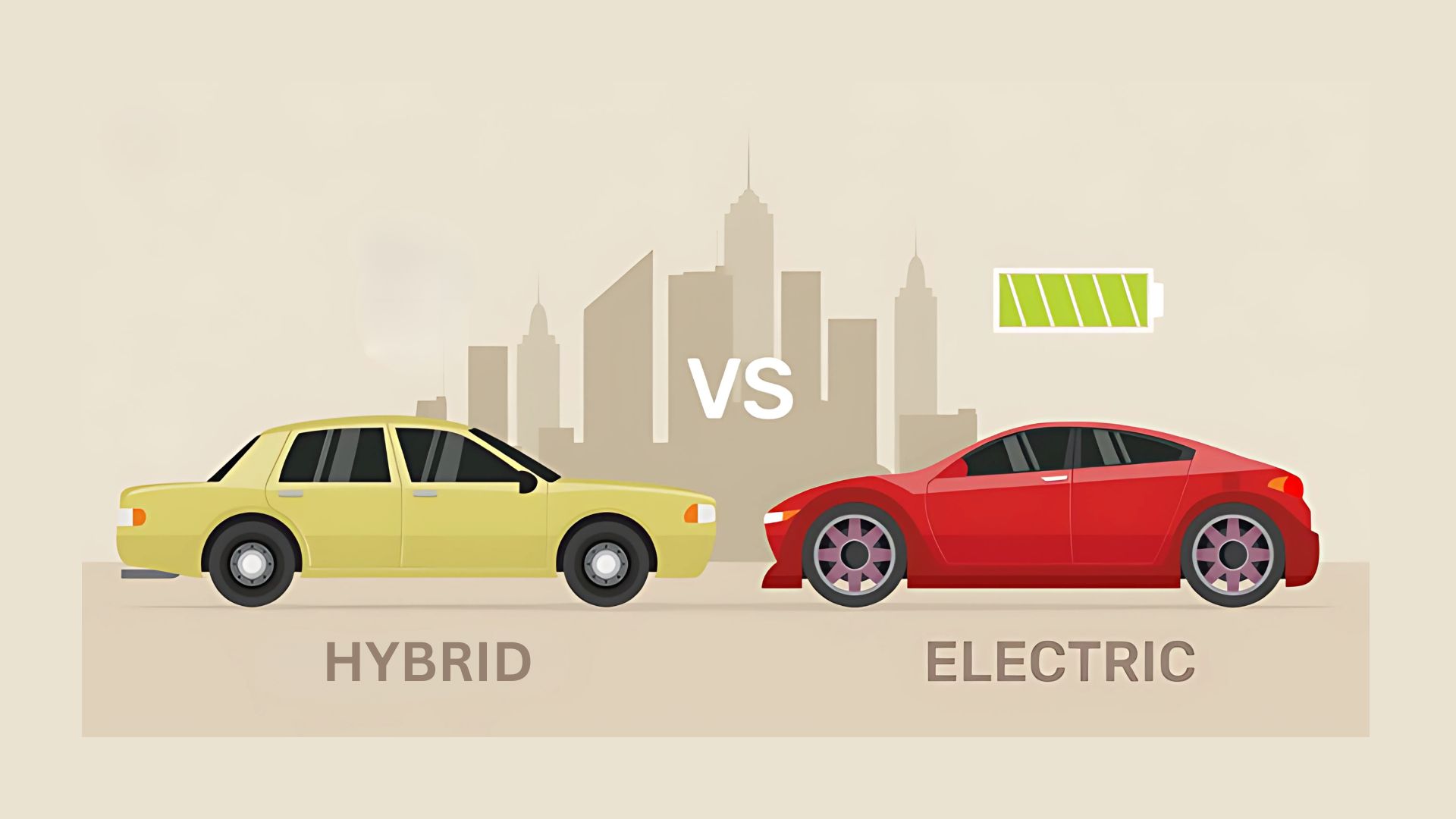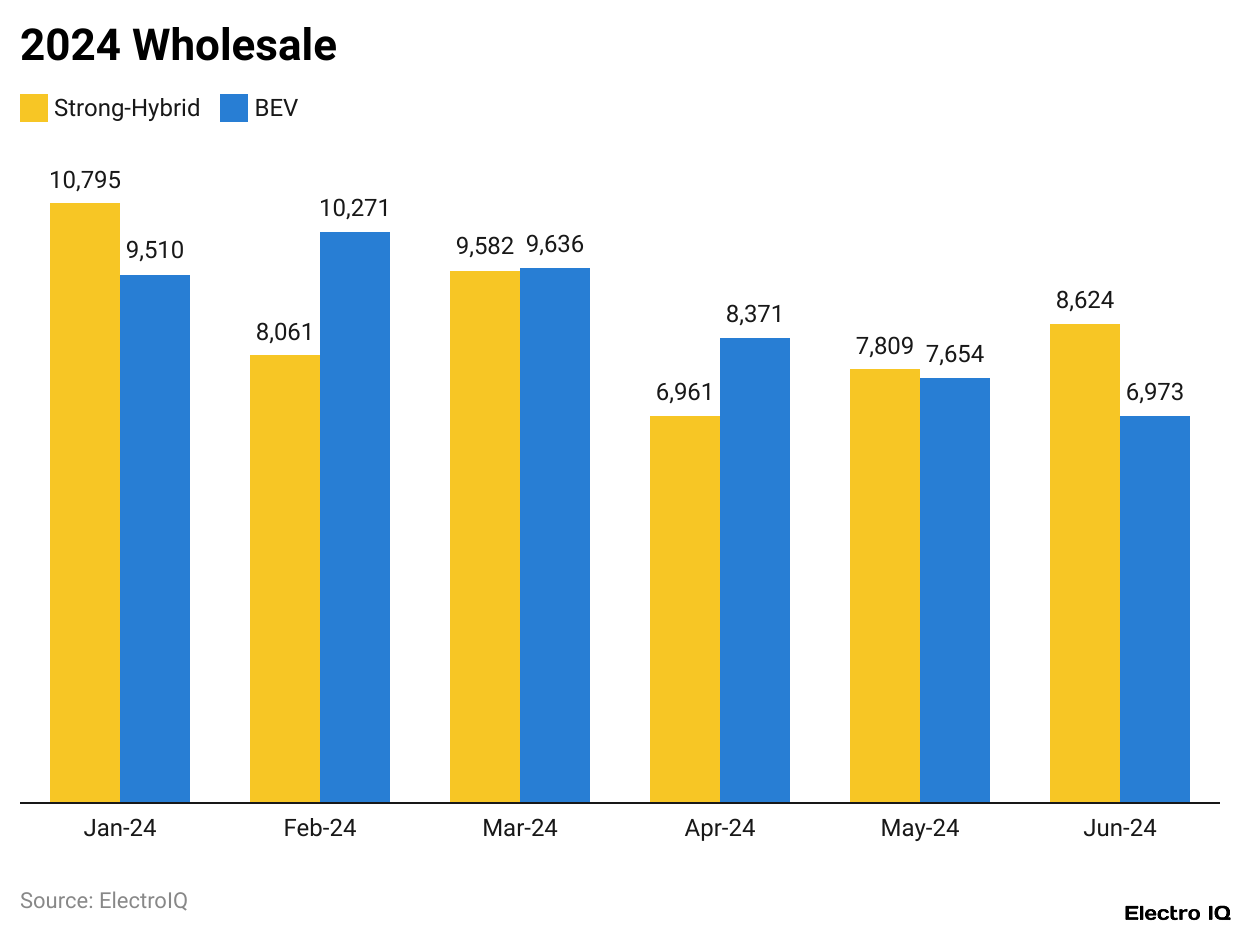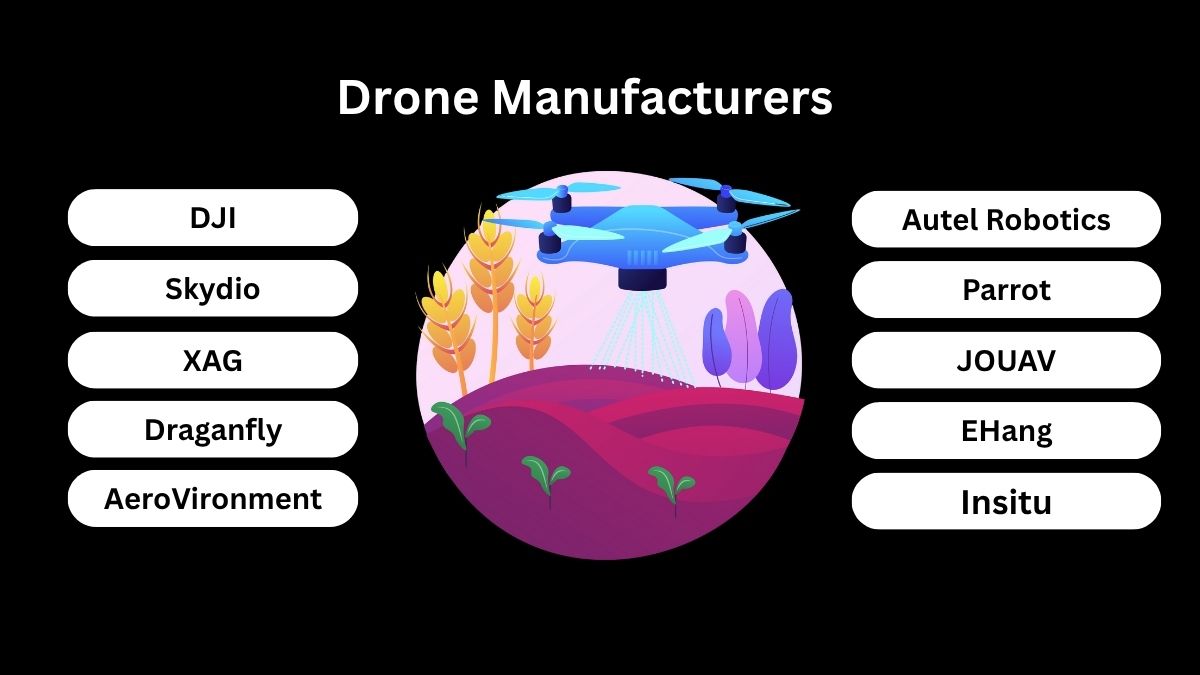Electric Car Vs. Hybrid Car Statistics – Which is the Right Fit for You? (2025)
Updated · Jul 08, 2025

Table of Contents
Introduction
Electric Car vs. Hybrid Car Statistics: The automotive industry is in an utter paradigm shift, getting on an uptrend for EVs and hybrids as major alternatives to conventional ICE vehicles. Environmental concerns coupled with technological developments may be steering the transformation, and it is quite crucial to apprehend the existing scenario with reference to electric and hybrid vehicles.
This article presents an analysis of the statistical data for the year 2024 and performs the comparison of Electric Car vs. Hybrid Car statistics in terms of market trends, costs, environmental impact, and regional adoption.
Editor’s Choice
- In Q1 2024, 22% of light-duty vehicles sold in the U.S. were hybrids, EVs, or plug-in hybrids, up from 18% in Q1 2023.
- Hybrid electric vehicles tend to gain market share more steadily compared to battery electric and plug-in hybrid vehicles.
- Battery electric vehicles and plug-in hybrids draw electricity from the grid for charging; however, hybrids do not affect electricity demand from the grid.
- Average transaction price for battery electric vehicles increased from $55,500 in Dec 2024 to $59,200 in Mar 2025, while the price average of all new vehicles fell to $47,500.
- EVs accounted for about 10% of the sales of new vehicles but for less than 2% of all vehicles on the road in 2023.
- Generally, from January to June 2024, hybrid vehicles out sold or were on par with EVs with a few fluctuations in the monthly performance.
- EV sales declined from 10,271 units in February to 6,973 units in June 2024, while hybrid sales increased from 8,061 to 8,624 units during the same period.
- In 2024, China has seen a very steep drop from Jan to Jun-91% to -29%. The respective hybrid growth remained positive, having witnessed a spike of 39% in April.
- The internal combustion engine (ICE) market share, in 2023, was 86.4% in Q1 and declined to 75.11% in Q4 of 2024.
- On the contrary, the share of hybrids more than tripled from 6.26% in Q1 2023 to 14.83% in Q4 2024.
- At the demand side, a plug-in hybrid share grew to 2.63% from 0.57% between Q1 2023 and Q4 2024.
- EVs are pricier, on average costing $58,940 versus $32,975 for a hybrid, though they may be eligible for up to $7,500 in federal tax credits.
- EVs have lower energy and maintenance costs per annum, estimated at $550 to $850 and $300 to $550, respectively, while the hybrid costs are $1,100-$1,500 for energy and $600-$1,000 for maintenance.
Electric Vs Hybrid Vehicles Sales Statistics

(Source: eia.gov)
- According to Ward Intelligence, Electric Car vs. Hybrid Car statistics show that roughly 22% of all light-duty vehicle sales in the U.S. in the first quarter were of hybrid electric vehicles (HEVs), battery electric vehicles (BEVs), or plug-in hybrid electric vehicles (PHEVs). This shows an increase from 18% for the same period in 2024, indicating that more Americans are choosing vehicles in some way powered by electricity.
- Between the aforementioned categories, hybrid electric vehicles are showing the largest amount of increase in market share.
- For their part, battery electric vehicles and plug-in hybrid vehicles show little or no growth and stand at about the same market level as last year, according to Wards Intelligence.
- The different categories of vehicles disperse different influences over the energy sector: BEVs and PHEVs require electricity either from the grid or from sometimes off-grid sources like home solar.
- With increased use, increased demand for electricity is exerted and so could affect generation capacity, power distribution, and planning within the grid. In contradistinction, HEVs do not require external charging; they run on gasoline and permanently generate electricity to be used by their electric motors. Hence, they do not increase the demand for electricity from the grid.
Electric Vs Hybrid Vehicles Sales By Powertrain And Market

(Source: eia.gov)
- Whereas any conventional automobile is relatively cheaper than a BEV, the latter is a costly affair for a potential buyer.
- BEV prices saw a creep in late 2024 and early 2025. From $55,500 in December 2024, the average transaction price of BEVs rose to $59,200 by March 2025.
- Contrarily, $49,700 was the average price for all new vehicles, which dropped to $47,500 in that same timeframe. This created a price gap in March 2025 that had lasted since April 2023 until then; it was about 25%.
- BEVs sell more and more, but they still represent quite a small fraction among all vehicles on U.S. roads. While EVs accounted for roughly 10% of new light-duty vehicle sales in recent times, their share of the total fleet is much smaller.
- According to the annual data from S&P Global, the U.S. Department of Energy reports on Electric Car vs. Hybrid Car statistics that electric vehicles accounted for less than 2% of all registered light-duty vehicles in the U.S. in 2023.
- This is to showcase that even with the fast growth, electric vehicles still need some time to form a sizeable stock in the general vehicle population.
Electric Car Vs Hybrid Car Sales

(Reference: autopunditz.com)
- As per Autopunditz, Electric Car vs. Hybrid Car statistics show that from January to June 2024, monthly sales data for strong-hybrid and electric vehicles (EVs) in the U.S. showed stiff competition, with hybrid vehicles slightly ahead overall.
- With 10,795 hybrids sold in January 2024, it was the month when hybrids led the U.S. sales compared to 9,510 units of EVs. But the trend flipped in February, with EV sales mounting to 10,271 units versus 8,061 units for hybrids.
- March was nearly a tie, with hybrids selling 9,582 units compared to EVs, which were just slightly ahead at 9,636.
- From April onwards, hybrid sales reclaimed the lead. In April, 6,961 units of hybrids were sold against 8,371 units for EVs, while the hybrids bounced back in May with 7,809 units versus 7,654 of EVs.
- Come June, however, the gap widened with lot sales at 8,624 units and EV sales reducing to 6,973. In essence, the data depict a landscape of monthly fluctuating yet competitive sales between the two categories, with hybrids just edging out in the lead in six months.
Electric Car Vs Hybrid Car Growth

(Reference: autopunditz.com)
- From January to June 2024, we saw the steady growth of strong hybrids, versus electric vehicles, which, after a fast start to the year, checked downhill sharply.
- In January, electric vehicles (EVs) experienced very high growth of 91%, surpassing hybrid growth of 67%. EV growth was still high in February at 69%, whereas hybrids grew by only 4%.
- Starting in March, momentum began shifting. With -4% EV growth, hybrid growth went up to 17% in March.
- This downhill trend for EVs continued in April at -2%, as opposed to hybrids, which saw a strong rebound at 39%.
- May saw hybrids maintaining solid growth at 28%, while EVs fell further to -10%. The divergence became much clearer in June, with hybrid growth at 26% and EVs undergoing their sharpest contraction yet at -29%.
- Overall, hybrids have shown steady and growing demand over the period, while EVs have shown early growth, followed by a steady and deepening decline in monthly growth rates.
| Fuel type | Q1 2023 |
Q2 2023 |
Q3 2023 |
Q4 2023 |
Q1 2024 |
Q2 2024 |
Q3 2024 | Q4 2024 |
| ICE | 86.40% | 83.15% | 81.20% | 82.00% | 78.16% | 75.47% | 74.17% | 75.11% |
| BEV | 6.77% | 8.67% | 7.43% | 7.07% | 8.72% | 8.10% | 6.59% | 7.42% |
| Hybrid | 6.26% | 7.49% | 10.31% | 9.46% | 11.95% | 14.93% | 16.70% | 14.83% |
| PHEV | 0.57% | 0.70% | 1.05% | 1.47% | 1.17% | 1.49% | 2.53% | 2.63% |
| HFCEV | 0.00% | 0.00% | 0.00% | 0.00% | 0.00% | 0.00% | 0.00% | 0.00% |
(Source: aaa.asn.au)
- The U.S. new light vehicle market, between the first quarter of 2023 and the fourth quarter of 2024, saw a steady drifting away from ICE vehicles in favour of hybrid and electric ones. In Q1 2023, ICE vehicles had an 86.4% share of new vehicle sales.
- That share, over the quarters, never rose but kept sinking all the way down to 75.11% come Q4 2024. From January to June 2024, we saw the steady growth of strong hybrids, versus electric vehicles, which, after a fast start to the year, checked downhill sharply.
- In January, EVs enjoyed very high growth at 91%, exceeding hybrid growth at 67%. EV growth was still high in February at 69%, whereas hybrids grew by only 4%.
- Starting in March, momentum began shifting. With -4% EV growth, hybrid growth went up to 17% in March.
- This downhill trend for EVs continued in April at -2%, as opposed to hybrids, which saw a strong rebound at 39%.
- May saw hybrids maintaining solid growth at 28%, while EVs fell further to -10%. The divergence became much clearer in June, with hybrid growth at 26% and EVs undergoing their sharpest contraction yet at -29%.
- Overall, as per Aaa.asn.au, Electric Car vs. Hybrid Car statistics show that hybrids have shown steady and growing demand over the period, while EVs have shown early growth, followed by a steady and deepening decline in monthly growth rates.
Electric Vs Hybrid Cars – Cost Comparison And Ownership Insights
- According to ccafs.net, Electric Car vs. Hybrid Car statistics show that electric vehicles and hybrid cars have different weighing factors on themselves between the initial purchase price and the long-term costs of ownership.
- A comparison of the cost structure for each vehicle will show how they fare relative to each other in categories such as purchase costs, fuel or battery charging expenses, maintenance, insurance, and battery replacement.
- In general, EVs are heavy hitters when it comes to being more expensive on an upfront basis, with the average figure cited at about $58,940, while standard hybrids pull off the cheaper side at just around $32,975. Plug-in hybrids take a middle stand.
- Federal tax credits of up to $7,500 are available to EVs to help reduce the initial purchase price.
- The credit is also available for use with plug-in hybrids, but not standard hybrids. The starting prices for EVs range between $35,000 and $125,000, while standard hybrids begin at $25,000 and plug-in hybrids start at $28,000.
- Operating expenses are another matter, and here is where EVs tend to be more economical. They run from about $550 to $850 a year in fuel or energy costs, while hybrids depend entirely on gasoline and thus cost from $1,100 to $1,500 in annual fuel charges.
- Maintenance-wise, EVs are cheaper to maintain, about $300 to $550 yearly, whereas hybrids’ upkeep costs range anywhere from $600 to $1,000. This is because EVs don’t need oil changes, spark plug replacement, or transmission maintenance, thus lowering maintenance costs by about 35% over 5 years.
- The insurance premium for an EV is slightly on the higher end, running around $1,600 to $2,200, with hybrids costing anywhere between $1,400 and $1,800.
- Another long-term consideration is battery replacement, with EV battery replacement costing between $5,000 and $15,000 every 8 to 10 years, while hybrid batteries, on the other hand, are cheaper, from $2,000 to $4,000 in the same time interval.
- Energy cost efficiency is also variable. EVs are approximately $0.04 per mile based on residential electricity rates, whereas hybrids running on gasoline can be around $0.08 per mile.
- These cost variances can become significantly high over the lifespan of the vehicle, thereby making EVs possibly cheaper over time, in spite of their initial purchase price.
Conclusion
Electric Car vs. Hybrid Car statistics 2024 marked as a year of advancement in both electric and hybrid vehicle adoption globally. While the other reduces pollution and raises the lower cost of operation, the hybrid, on the other hand, serves as an interim solution for buyers not ready to make a settled leap toward electric mobility. With further developments in technology and enhancement of the infrastructure, both kinds of vehicles will ultimately pave the way toward sustainable transportation.
Sources

Joseph D'Souza founded ElectroIQ in 2010 as a personal project to share his insights and experiences with tech gadgets. Over time, it has grown into a well-regarded tech blog, known for its in-depth technology trends, smartphone reviews and app-related statistics.










